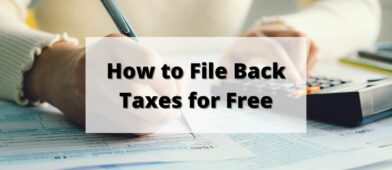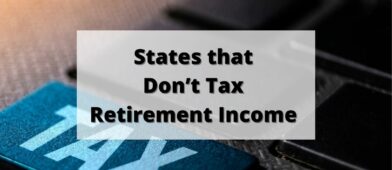Many people want to file a tax return early to start planning the rest of this year’s financial goals, like car repairs and vacation. Filing your taxes as soon as possible can help you get a tax refund quickly. And if you owe taxes, finding out early can give you time to plan.
When filing your taxes in 2024, you are filing a return for income earned in 2023. It gets confusing when 2023 and 2024 are used interchangeably to describe the same task, but welcome to taxes! 😂
Here are the key details to know about filing taxes and answers to common tax questions.
📓Quick Summary: You can file your taxes as soon as you have all of your documentation and when the IRS has stated they will accept tax returns. For 2024, the IRS has already announced they are accepting returns as of January 29th. Banks have until January 31st to issue 1099s and businesses have until February 1st to send out their 1099 forms. If you feel confident you have all of your documents (and thus all of your financials in order), you can file right now because the IRS is accepting returns.
Table of Contents
- When Can You File Your 2024 Tax Return?
- When is the Federal Income Tax Deadline?
- Why You Should File Your Tax Return as Early as Possible
- Other Income Tax Deadlines to Know
- Tax Estimates for the Self-Employed and Others with Additional Tax Liability
- Small Businesses
- What Tax Documents Do I Need?
- How Do I File My Own Taxes?
- When Will I Receive My Tax Refund?
- Can I File My Taxes Now?
- Summary
When Can You File Your 2024 Tax Return?
You can prepare your income tax return any time after the end of the 2023 calendar year. You’re really just waiting for all the necessary documents and information, but you can’t file the return immediately.
Each year, the IRS announces when the tax season “starts” and when you can file a return.
For 2024, the IRS announced that the tax season would start on Thursday, January 29th, 2024.
If you are ready to start preparing your return here’s where you can file for free.
✨ Related: Do You Need to File a Tax Return?
When is the Federal Income Tax Deadline?
The deadline to pay your federal taxes is typically April 15th and your state deadline is usually the same day. It can change based on the day of the week, with it sliding due to weekends or holidays.
For 2024, the tax due date is April 15th.
If you owe the IRS money with a tax liability, payment is due by this date to avoid penalties and interest.
You can file an automatic six-month filing extension using IRS Form 4868 if you need more time to prepare your return. The tax filing deadline for the extension is October 15.
However, any taxes you owe are still due on April 15th, even if you get an extension the deadline to file. So, if you think you may owe money, you can make an estimated payment before April 15 to minimize a tax penalty on any unpaid taxes.
If you’re eligible to receive a tax refund, you can file penalty-free after the deadline.
April 15, 2023, is the due date for estimated taxes from January 1 to March 31, 2023.
The state income tax deadlines vary by state and can be later than the federal deadline.
Why You Should File Your Tax Return as Early as Possible
While some taxpayers don’t even begin thinking about income tax filing until March – and for a few, not until April – that won’t be the best strategy for most taxpayers.
There are two primary reasons to file your tax return as early in the year as possible:
To get your refund as soon as possible. According to the IRS, the average income tax refund in 2023 was $3089, which doesn’t include any state income tax refunds. According to the IRS, refunds were issued to 94.8 million taxpayers. (As reported on October 28th, 2023)
To minimize the possibility of fraud. Scammers have found ways to file a fraudulent tax return using your personal information, which can include your name, Social Security number, and address. They’ll file a return very early in the year, claiming a large refund. By filing early, you’ll reduce the possibility of this happening. Here’s more about that.
On the first point, it’s also worth noting that the earlier you file during the tax season, the faster the return will be processed.
For example, if you file in February, you’ll likely receive your refund within two weeks. But if you wait until early April, it may be delayed as long as three or four weeks. That’s because processing times get longer as more returns are filed. By filing early, the stream of incoming returns at the IRS will be lighter.
Other Income Tax Deadlines to Know
Though the individual income tax filing deadline (normally April 15th) and the extension filing date (October 15th) are important to most taxpayers, there are some other deadlines. These primarily apply to those who don’t have federal income tax withheld and anyone who expects to owe additional tax.
Examples of individuals who may owe additional tax include the following:
- Freelancers.
- Full-time employees who also have a side business.
- Individuals who receive significant investment income.
- Social Security, pension, and retirement distribution recipients (though withholding can usually be established with each income type).
- Recipients of a large amount of unemployment insurance.
- Anyone who receives a taxable windfall, such as from the sale of an investment property, undeveloped land, or a business asset.
Each of the above activities or events can result in an additional income tax liability, which will require the payment of tax estimates over and above any withholding you may have on your regular earnings from employment.
Tax Estimates for the Self-Employed and Others with Additional Tax Liability
The IRS expects taxpayers to pay the additional tax liability in the quarter in which it’s earned. Many self-employed individuals who have their returns either professionally prepared or self-prepared using tax-preparation software, will have those estimates prepared in advance based on the previous year’s tax liability.
Those estimates must be paid by check and including IRS Form 1040-ES, or online through IRS.gov Paying Your Taxes.
For the 2024 tax year, the dates to pay estimated taxes are:
| Earning Period (Quarter) | Due Date |
|---|---|
| First Quarter (income earned Jan – March) | April 15th, 2024 |
| Second Quarter (income earned April – June) | June 17th, 2024 |
| Third Quarter (income earned July -Sept) | September 16th, 2024 |
| Fourth Quarter (income earned Oct – Dec) | January 15th, 2025* |
Small Businesses
If you have a small business and file your business income and expenses on Schedule C of your individual 1040, your business and individual filing deadline will be the same – April 15, 2024.
But if you operate your business as either a partnership or an S corporation, you’ll be required to file a tax return for your business by March 15, 2024.
That will include an IRS Form 1065, U.S. Return of Partnership Income for partnerships, or IRS Form 1120-S, U.S. Income Tax Return for an S Corporation for a Subchapter S corporation.
If you can’t file either return by the deadline, you’ll have a six-month extension to file, which will move the due date out to September 16, 2024.
Since the income from both partnerships and S corporations flows directly through to your individual income tax return, neither business tax return will typically require a tax payment.
However, business tax returns are due to be filed at least 30 days before individual income tax returns to give the individual taxpayer the final income numbers to report on his or her individual return. For that reason, filing an extension on a business tax return may also require getting an extension on your individual return – unless the business tax return will be filed before April 15.
What Tax Documents Do I Need?
Here is a list of common forms you’ll need to prepare your taxes (until you get these all, you won’t know your total income):
- Employment income (Form W-2 or Form 1099)
- Bank account interest (1099-INT)
- Investment income (1099-DIV, 1099-B, 1099-MISC, 1099-R)
- Social Security income (1099-SSA)
- Unemployment income (1099-G)
- Student loan interest payments (1098-E)
- Rental property income
Employers will mail their W-2 forms by January 31. Banks usually send their 1099-INT forms by January 31st.
Online brokers may not complete your tax forms before mid-February. Each broker has different publishing deadlines, and checking their tax center for the available dates is your best option.
For less common investments, the investment income is reported on a Schedule K-1 instead of a 1099 form. Examples include real estate partnerships or oil and gas stocks that are a Master Limited Partnership (MLP). Most K-1 tax forms are distributed in mid-March and come directly from the company you own shares of.
If you can itemize your taxes, you should also gather these tax documents:
- Charity donations (cash and non-cash)
- Home mortgage interest payments
- Local and state property taxes
- Childcare expenses
- Medical expenses
How Do I File My Own Taxes?
The easiest way to file your taxes is using online tax software.
Some of the most popular options include:
- TurboTax (see our TurboTax review)
- H&R Block (see our H&R Block review)
- TaxAct (see our TaxAct review)
- FreeTaxUSA (see our FreeTaxUSA review)
TurboTax and H&R Block can be the most expensive if you don’t qualify for their free filing option. But these two platforms offer more tools and hands-on help, such as expert tax assistance.
Discount tax software has fewer features and can be a little more difficult to use than the pricier alternatives. However, you can get similar results and spend less money.
Can I File My Taxes for Free?
Yes, it’s possible to get free tax filing. Most tax software only lets you file simple tax returns for free when you only have these tax details:
- W-2 income
- Retirement income
- Unemployment benefits
- Bank account interest
- Stock investment dividend income
Most platforms require you to pay if you earn freelancer/self-employment income reported on a Form 1099-MISC, or have itemized deductions. You will also need to pay to file if you sell investments, cryptocurrency, or earn rental property income.
Some allow common credits, such as the child tax credit or earned income tax credit, and some don’t. So, make a note of what tax situations qualify before you begin. Not all companies have the same rules for their free programs.
Here’s our full list of where you can file your taxes for free or at a discount.
When Will I Receive My Tax Refund?
If you file electronically, the IRS processes most tax refunds within 21 days. If you mail in a paper return, expect your refund in about four weeks after mailing. E filing your federal tax return cuts out the processing time of mailing and manually entering in your information.
You can track your refund status on the IRS website.
Direct deposit into a bank account can be the quickest way to receive a refund. You can also receive your refund by paper check, which takes longer to receive your funds.
You can contact the IRS to investigate your missing tax refund if it’s been longer than 21 days for e-file returns or six weeks for paper returns.
What is a Tax Refund Loan?
Some tax prep software offer “tax refund loans” or a “refund advance.” This interest-free loan is usually between $500 and $4,000 of your federal tax refund amount and typically doesn’t have hidden fees – but always double-check.
The tax software loads the refund advance onto a prepaid debit card once the IRS approves your tax return and refund amount. Then, the IRS sends the refund to the tax preparer to pay off the advance.
Extra fees apply if you pay your tax prep fees with your tax refund instead of paying the fees upfront.
Can I File My Taxes Now?
The IRS announced you can file your taxes starting January 29, 2024.
During the tax interview, online tax software will ask if you have any special tax situations. If you’re unsure what tax credits and tax deductions you qualify for, the tax prep software helps you find out.
If you owe a tax liability, consider making a traditional IRA contribution to reduce your taxable adjusted gross income. In 2023, individuals can make up to $6,500 ($7,500 if age 50 or older) in combined traditional IRA and Roth IRA annual contributions. ($7,000/ $8,000 in 2024)
The IRA contribution deadline is April 15, 2024, for calendar year 2023 contributions. So if you didn’t max out your 2023 IRA contributions, you can still contribute for last year.
Summary
Now that you know when you can file your 2024 tax return, it’s time to prepare your tax documents. Filing with online tax software can be the easiest way to complete most tax returns, and more platforms offer tax expert packages that can be cheaper than hiring a tax preparer.



